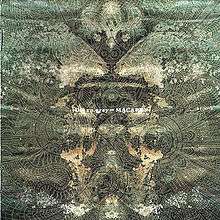Macabre (album)
| Macabre |
|---|
|
|
| Studio album by Dir En Grey |
|---|
| Released |
September 20, 2000 |
|---|
| Recorded |
Warner Studio, Studio Greenbird, WestSide Studio |
|---|
| Genre |
|
|---|
| Length |
72:57 |
|---|
| Language |
|
|---|
| Label |
Firewall Div./SMEJ |
|---|
| Producer |
- Dir En Grey
- Tatsuya Sakamoto (Track 2)
- Hoppy Kamiyama (Track 7)
|
|---|
| Dir En Grey chronology |
|---|
|
|
|
| Singles from Macabre |
- "Myaku"
Released: February 16, 2000
- "[KR]cube"
Released: June 7, 2000
- "Taiyou no Ao"
Released: July 26, 2000
|
Macabre is the second studio album released by Dir En Grey on September 20, 2000. It is the band's first record to be released in collaboration of Free-Will's Firewall sub-division and Sony Music Entertainment Japan. The original print of Macabre featured an etched, tinted jewel case with 5 wooden beads placed within the spine. The album proper, like Gauze, included two booklets: one with the lyrics, and the other featuring a related image and poem.
Track listing
All lyrics written by Kyo[1].
| 1. |
"Deity" | Dir En Grey |
4:15 |
| 2. |
"Myaku" (脈; "Pulse") | Dir En Grey |
4:05 |
| 3. |
"Wake" (理由; "Reason") | Die |
5:12 |
| 4. |
"Egnirys Cimredopyh
+) An Injection" | Toshiya |
5:16 |
| 5. |
"Hydra" | Kaoru |
5:41 |
| 6. |
"Hotarubi" (蛍火; "Light of a firefly") | Shinya |
6:06 |
| 7. |
"[KR]cube" | Dir En Grey |
4:09 |
| 8. |
"Berry" | Kaoru |
4:20 |
| 9. |
"Macabre -Sanagi no Yume wa Ageha no Hane-" (MACABRE —揚羽ノ羽ノ夢ハ蛹—; see notes) | Kaoru |
10:49 |
| 10. |
"Audrey" | Die |
4:33 |
| 11. |
"Rasetsukoku" (羅刹国) | Dir En Grey |
3:35 |
| 12. |
"Zakuro" (ザクロ; "Pomegranate") | Kaoru |
8:37 |
| 13. |
"Taiyō no Ao" (太陽の碧; "Blue of the sun") | Kaoru |
6:19 |
Notes
- The album features Russian imagery; the artwork contains Cyrillic; the lyrics for "Deity" is written in Russian; and the song "Rasetsukoku" translates to "Man-eating devil country", which was the Chinese name for Russia during the Qing Dynasty.
- "Deity" is similar to the Russian word for children, "deti" ("дети"). The accompanying image in the lyric booklet is of a pregnant woman's stomach. A portion of the melody in "Deity" appears to be derived from Johannes Brahms' Hungarian Dance No. 5.
- "理由" officially romanizes as "riyū", yet is transliterated in this case by the band as "wake"; both "wake" ("訳") and "riyū" ("理由") can be translated as reason.
- "egnirys cimredopyh" is hypodermic syringe spelled backwards; it was written in this manner due to the censorship board in Japan.
- "蛍火" romanizes as both "Hotarubi" and "Keika". Both translate as "light of the firefly".
- The lyrics of "Berry" is written from a abused child's point of view.
- When read left to right, "Macabre"'s subtitle "揚羽ノ羽ノ夢ハ蛹" transliterates as "Ageha no hane no yume wa sanagi", or "The Swallowtail's Wings' Dream is the Chrysalis". However, the title contains numbered furigana above it, which suggests that the title is to be read as "Sanagi no yume wa ageha no hane", or "The Chrysalis' Dream is the Swallowtail's Wings".
- "Taiyou no Ao" uses kanji meaning "midori" (green). However "ao", the word for blue, can also mean green. So the translation could be either Green, Blue, or Jade Sun.
- A rearrangement of the track "Hydra" appears on their 2007 single "Dozing Green" as a B-side.[2]
- A re-recording of the track "Rasetsukoku" appears as a bonus track on their 2011 album Dum Spiro Spero.
- A re-recording of the track "Macabre -Sanagi no Yume wa Ageha no Hane-"(Simply titled MACABRE) appears on the second disc of the Limited Edition of their 2013 mini-album The Unraveling.
Chart positions
| Year |
Chart |
Position |
|---|
| 2000 |
Oricon |
4 |
|
Personnel
|
|
- Hoppy Kamiyama – producer
- Chieko Kinbara – violin (Hotarubi)
- Hiroshi "Dynamite Tommy" Tomioka – executive producer
- Koji Yoda – art director
- Hidemi Ogata – cover art
|
References
|
|---|
| | | | Albums | |
|---|
| | EPs | |
|---|
| | Compilations | |
|---|
| | Singles | |
|---|
| Music video
compilations | |
|---|
| | Live videos | |
|---|
| | Related articles | |
|---|
|
